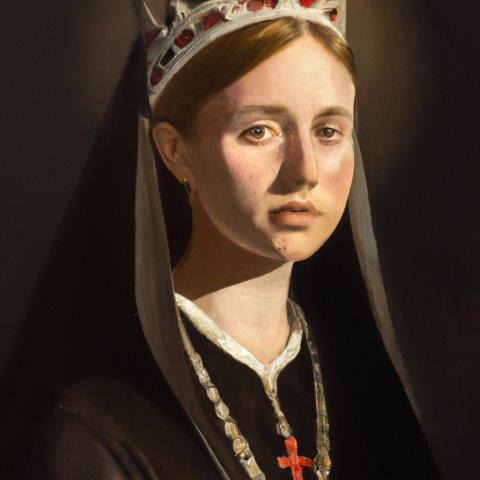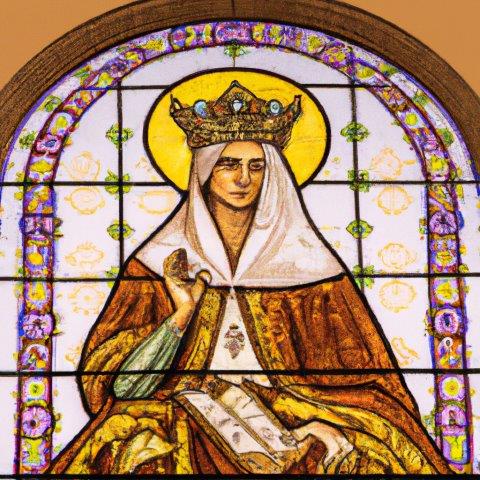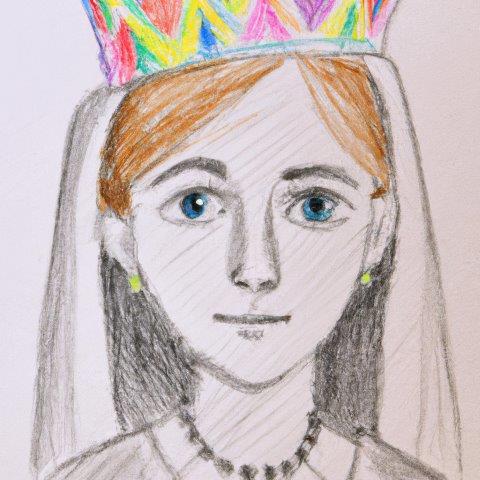Saints
St. Elizabeth of Hungary – 5 lessons for a holy marriage
“And they shall be two in one flesh. Therefore now they are not two but one flesh. What therefore God hath joined together, let no man put asunder.” (Mark, Ch. 10, v. 8-v. 9.)
 St. Elizabeth of Hungary was a Catholic saint, who lived in the 13th century. She was born in 1207 in Pressburg, Hungary, now known as Bratislava, Slovakia. She was the daughter of King Andrew II of Hungary and Gertrude of Merania.
St. Elizabeth of Hungary was a Catholic saint, who lived in the 13th century. She was born in 1207 in Pressburg, Hungary, now known as Bratislava, Slovakia. She was the daughter of King Andrew II of Hungary and Gertrude of Merania.
As a child, Elizabeth was known for her piety and devotion to God. She was educated by the Cistercian nuns and was fluent in several languages, including Hungarian, German and Latin. At the age of 14, she was married to Louis IV, Landgrave of Thuringia in Germany, as part of a political alliance between Hungary and Thuringia.
Despite her privileged upbringing, Elizabeth chose to live a simple and humble life. She was known for her charity towards the poor, and she built a hospital in Wartburg, where she would often visit and care for the sick. She also gave away much of her wealth to the poor, even to the point of angering her husband and his court.
Elizabeth was a devoted mother to her three children, and she also continued to work for the poor. She was a patron of the arts, and her court was known for its cultural and intellectual achievements. She also continued to practice her devotion to God and her spiritual life, and was known for her deep devotion to the Eucharist and to the Virgin Mary.
After the death of her husband in 1227, Elizabeth faced many difficulties. Her in-laws and her own brothers sought to take her children away from her, and she was even forced to flee from Wartburg. She took refuge in the Cistercian convent at Marburg, where she joined the Third Order of St. Francis and dedicated her life to God and to service of the poor.
Elizabeth lived the rest of her days in poverty and simplicity, serving the poor and caring for the sick, becoming a model for other religious people and laypeople who wanted to imitate her life of devotion, charity and holiness.
Elizabeth died on November 17, 1231, at the age of 24, in Marburg, Germany. Her tomb became a site of pilgrimage and many stories of miracles were attributed to her intercession. In 1235, Pope Gregory IX formally recognized Elizabeth as a saint, and her cult spread throughout Europe.
St. Elizabeth of Hungary is widely venerated as a saint and a model of charity and devotion. Her feast day is celebrated on November 17, and she is considered the patron saint of bakers, beggars, widows, and the Third Order of St. Francis. She is remembered for her deep piety, her humility and her generosity to the poor and the suffering.
The Life of St. Elizabeth of Hungary
 It is interesting to note that there are countless saints who were single women, and were women who had entered the holy state of Matrimony. Amongst the most popular unmarried saints- Teresa, Therese, Hilda, and Frances Cabrini, dedicated themselves to a life of religious vows and enclosure, while others such as Catherine of Siena, Joan of Arc, Zita, and Rose Lima, were all young women who lived and worked in the world. Many other saints saints, among whom the greatest is Our Blessed Lady, herself, were united in marriage.
It is interesting to note that there are countless saints who were single women, and were women who had entered the holy state of Matrimony. Amongst the most popular unmarried saints- Teresa, Therese, Hilda, and Frances Cabrini, dedicated themselves to a life of religious vows and enclosure, while others such as Catherine of Siena, Joan of Arc, Zita, and Rose Lima, were all young women who lived and worked in the world. Many other saints saints, among whom the greatest is Our Blessed Lady, herself, were united in marriage.
For some, this married state was the occasion of temporary or perpetual unhappiness, as it was with Monica of Tagaste, and Helena of Constantinople. For the others, however, great happiness and affection was the keynote of their married life. Many outlived their husbands, and several, like Louise de Marillac, Hedwig of Poland, and Elizabeth of Hungary, lived as religious, after their husbands had passed on to their eternal reward. All of them, too, exemplified wifely devotion to their respective spouses and were real Christian mothers to their children.
St. Elizabeth of Hungary – Counsellor of Happiness in Marriage
St. Elizabeth of Hungary, however, who is usually remembered and praised for her outstanding charity, excelled in a very special way, in true marital love and devotion, and she can be called, in every sense, the prominent example for the Cath olic woman of today who makes this sacred contract of Matrimony in the eyes of God.
Although this saint is called, “St. Elizabeth of Hungary”, she can really be claimed by two countries, Hungary, the country of her birth, and Germany, where she ruled in Thuringia as Queen. Her life reads like the background of a tragic opera, for it had all the elements of supreme joy and pathetic sorrow that can befall any member of the human race.
St. Elizabeth joins the Franciscans
 It should be remembered that St. Elizabeth and St. Francis of Assisi were contemporaries, and the Franciscan way of life was beginning to spread its way of life throughout the continent of Europe at this time. Even before the death of her husband, Elizabeth had become a member of the Third Order of St. Francis, when this pious organization for Lay people was in its incipient stages.
It should be remembered that St. Elizabeth and St. Francis of Assisi were contemporaries, and the Franciscan way of life was beginning to spread its way of life throughout the continent of Europe at this time. Even before the death of her husband, Elizabeth had become a member of the Third Order of St. Francis, when this pious organization for Lay people was in its incipient stages.
When the remains of Ludwig were finally returned to Germany, Elizabeth and Ludwig’s brother, Heinrich, were reconciled at the funeral which was held at Bamberg Cathedral, where Elizabeth’s uncle and protector was bishop. Certain properties were restored to Elizabeth, among which were the castle at Marburg and the castle at Eisenach where she had established foundations for the poor. From this time on, having refused an offer of marriage from the Emperor Frederick, who admired her beauty and holiness, St. Elizabeth wore the Franciscan habit and devoted the remainder of her life to the care of the poor and the sick.
Under the direction of her confessor, Konrad, who was extremely strict and almost cruel, according to our present methods of accepted spiritual guidance, St. Elizabeth with great piety continued her religious and charitable exercises, until her premature death at the age of twenty-four years, a time when most young women of today are just embarking upon their careers of marriage and motherhood. Yet, at that early age, St. Elizabeth was the mother of four children, a widow, a reigning monarch and a religious. She had seen every phrase of joy and sorrow that the world can offer. She accomplished much in a short time.
The Sainthood of Elizabeth of Hungary
After her death on November 17, 1231, and even before her burial, miracles occurred in great numbers, the cure of the blind and the lame, the healing of paralytics and lepers, and she was finally canonized on May 26, 1235, less than four years after her death. Her remains were transferred to Marburg after her canonization, and her body, which was found to be quite incorrupt, was exposed for public veneration. At that time, Emperor Frederick II, who had once asked her hand in marriage paid Elizabeth a beautiful and touching tribute. He laid upon her shrine a crown of gold, and said: “Because in your lifetime, you would not be crowned as my Empress, I wish now to crown you as a Queen in the Kingdom of God.”
A great many salutary thoughts for our spirit al growth can be found in the life and the deeds of this great Saint, who might be called the “Saint of Constant Giving.” Certainly her unparalleled works of Charity, her loving care of the impoverished and the sickly can be imitated by every follower of Christ, who seeks to imitate Our Divine Saviour, as she did so wonderfully in her brief span of life.
The married woman, above all, can imitate St. Elizabeth, who knew full well that even before her great charitable works for others, charity began at home, and this charity found itself realized in her great love for her husband even after death.
PRAYERS TO ST. ELIZABETH OF HUNGARY
O God of Mercy, enlighten the hearts of your faithful and grant us grace through the prayers of the glorious blessed Elizabeth, so that we may scorn the wealth of the world and see Heaven as our joy and consolation. Through our Lord.
O God, by whose gift Saint Elizabeth of Hungary
recognized and revered Christ in the poor,
grant, through her intercession,
that we may serve with unfailing charity
the needy and those afflicted.
Through our Lord Jesus Christ, your Son,
who lives and reigns with you in the unity of the Holy Spirit,
one God, for ever and ever. Amen.
Dear Saint Elizabeth, you were always poor in spirit, most generous toward the poor, faithful to your husband, and fully consecrated to your Divine Bridegroom. Grant your help to widows and widowers and keep them faithful to their heavenly Lord. Teach them how to cope with their loss to make use of their time in the service of God our Lord. Amen.
St. Elizabeth, you were able to give up a life of honor and wealth and live simply. Pray for us, that we will not be bound to the material things of this life, but always live our lives devoted to God. Amen.
Prayer to St. Elizabeth of Hungary
Dear St. Elizabeth,
You were known for your kindness, charity, and love for the poor.
Inspire us to follow your example and to serve others with a selfless heart.
Help us to see the value in every person, regardless of their circumstances, and to love them as you loved.
Prayer of devotion to St. Elizabeth of Hungary
Oh St. Elizabeth, you lived a life of devotion and generosity.
Grant us the grace to imitate your virtues and to use our blessings to serve others.
Teach us to be humble and to always put the needs of others before our own.
Help us to follow your example and to bring peace and joy to those around us.
Prayer to St. Elizabeth Queen of Hungary
St. Elizabeth, Queen of Hungary,
You were known for your devotion to God and for your love of the poor.
Grant us the courage to live our lives with love and compassion for others.
May we follow your example and always seek to bring comfort to those in need.
We ask this through Christ our Lord. Amen.
Popular St. Elizabeth of Hungary Medal and St. Elizabeth of Hungary Rosary
Patron Saints - E's
St. Elizabeth of Hungary: The Patron Saint of the Sick and the Poor
 St. Elizabeth of Hungary is widely recognized as the patron saint of the sick and the poor. Her life and works embody the ideals of charity, compassion, and service to those in need, and her story continues to inspire and encourage Catholics around the world.
St. Elizabeth of Hungary is widely recognized as the patron saint of the sick and the poor. Her life and works embody the ideals of charity, compassion, and service to those in need, and her story continues to inspire and encourage Catholics around the world.
St. Elizabeth was born into a wealthy and powerful family, but she renounced her luxurious lifestyle and dedicated her life to helping the poor and the sick. She was known for her kindness and compassion, and she would often distribute her wealth to those in need, visiting the sick and caring for them in their homes.
In addition to her acts of charity, St. Elizabeth was also a woman of great faith and devotion, and she is remembered for her devotion to God and her unwavering commitment to the poor. Her life was a testament to the power of love and compassion to transform the world, and she continues to inspire Catholics today to follow her example and to work towards a more just and equitable society.
As the patron saint of the sick and the poor, St. Elizabeth is often invoked for protection and guidance in caring for those in need. Her feast day is celebrated on November 17th, and it is customary for Catholics to attend Mass in her honor and to pray for the continued growth of the Church’s ministry to the sick and the poor.
Through their own acts of charity and service, Catholics around the world strive to embody the ideals of St. Elizabeth and to continue her mission of bringing comfort, hope, and healing to those in need. Whether through acts of kindness and compassion or through supporting the Church’s work to care for the sick and the poor, St. Elizabeth’s legacy continues to inspire and encourage Catholics to work towards a more just and compassionate world.
Reflection on the feast day of St. Elizabeth of Hungary
 The feast day of St. Elizabeth of Hungary is on November 17th.
The feast day of St. Elizabeth of Hungary is on November 17th.
St. Elizabeth of Hungary was a princess of the Kingdom of Hungary in the 13th century. She is remembered for her deep devotion to God, her charity and her service to the poor. She was known for her selfless service to the poor and her work in hospitals and orphanages. She is the patron saint of bakers, beggars, charities, death of children, falsely accused people, hospitals, in-law problems, widows, and the Third Order of St. Francis.
On the feast day of St. Elizabeth, we are called to reflect on her life and the example she set for us. We can learn from her deep devotion to God, her commitment to serving others and her selfless charity towards the poor. She is a model of humility and of putting the needs of others before her own.
St. Elizabeth’s devotion to God was not only a personal matter but also a way to serve others and to bring the light of Christ to those around her. She lived a life of service, particularly to the poor and the sick, and it was through this service that she was able to deepen her own faith and draw closer to God.
St. Elizabeth’s example teaches us the importance of charitable works and service to the poor, her devotion to God, and her commitment to the poor, all of which are essential for the spiritual growth and development. She is a model for those who want to live a life of holiness and service to the community.
Let us ask for the intercession of St. Elizabeth, that we may be inspired by her example to deepen our own devotion to God, to serve others, particularly the poor and the needy.
Discover biographies, prayers, and reflections for more than 400 Catholic Saints
6 Lessons St. Elizabeth of Hungary Teaches Us About Marriage
She was born in Hungary in the year, 1207, the daughter of King Andrew and his wife Gertrude. Her mother’s sister was St. Hedwig of Poland, so it seems that sanctity was something of an heirloom in her family True to the royal custom of the era, Elizabeth was betrothed at the age of four to Ludwig, a German prince. Thus her marriage was destined to be purely a dynastic union, arranged when she was still hardly more than an infant, to cement a political alliance between Hungary and Germany. Yet when this marriage was finally realized it proved to be one of the greatest love stories of all time.
1) True Life-Long Love Does Exist
 At the age of four, the tiny Elizabeth was escorted by her father King Andrew across the great country of Germany, carried in a silver cradle, and dressed in silk robes embroidered with gold. She was accompanied by two small companions who were to remain with her in her future country. When Elizabeth and her father arrived in the land of the great stone castles, their destination was the already famous Wartburg Castle, where Elizabeth was to be reared as the future wife of Ludwig, a castle whose fame would increase in history for having been blessed by her presence.
At the age of four, the tiny Elizabeth was escorted by her father King Andrew across the great country of Germany, carried in a silver cradle, and dressed in silk robes embroidered with gold. She was accompanied by two small companions who were to remain with her in her future country. When Elizabeth and her father arrived in the land of the great stone castles, their destination was the already famous Wartburg Castle, where Elizabeth was to be reared as the future wife of Ludwig, a castle whose fame would increase in history for having been blessed by her presence.
After much opposition on the part of Ludwig’s mother and some court officials, who wanted to break off the betrothal and send Elizabeth back to Hungary, she and Ludwig IV of Thuringia, who had literally grown up together with a great fondness for each other, were finally married. Elizabeth was only fourteen years of age at the time of their marriage. Ludwig’s father had died several years before this time, and so Ludwig was actually the ruler of his domain.
St. Elizabeth of Hungary is a Model of Holy Love in Marriage
From the very outset of their married life Elizabeth and Ludwig were deeply in love and they remained so until his untimely death, amid the intrigues of court life and the many worries that beset the rulers of any country. The German Thuringian court continued to dislike Elizabeth, partially because she was Hungarian, and also because she was so devoted to her husband.
Such devotion between a husband and wife, in courtly circles, was not particularly common at the time, when husband and wife sat at different tables in public. Because of so many arranged marriages, the artificial system of courtly love was commonly accepted as a conventional thing, and infidelity was cynically accepted. To the amazement of the sophisticated court and Ludwig’s mother, Sophia, who tried her utmost to ruin their marriage, they continued to be a very happily married couple completely considerate of one another in all things.
2) Show love through the little things in life
They had four children from this happy union, the last child being born after Ludwig’s untimely death. Elizabeth’s passionate affection for her husband, Ludwig, was shown in a great many ways. Whenever he went out hunting, Elizabeth would ride with him if the journey were not too far or arduous. Whenever Ludwig was required to be away for any length of time on affairs of state, Elizabeth, to show her wifely devotion, would put on widow’s garments of mourning, changing them into the richest clothing only upon the news of his return.
3) Love for a spouse spills over to love for others
 During these six years of marital bliss, Elizabeth also had another love, which she manifested as a very young girl prior to her marriage, and that love was for the poor, the sick, and the needy. A whole book could be written about the charitable works of this great saint, who was the complete personification of the Spiritual and Corporal works of Mercy.
During these six years of marital bliss, Elizabeth also had another love, which she manifested as a very young girl prior to her marriage, and that love was for the poor, the sick, and the needy. A whole book could be written about the charitable works of this great saint, who was the complete personification of the Spiritual and Corporal works of Mercy.
Every day, scores of hungry people, sick people, and lepers clambered up the castle stairs, and no one, it is said, was ever turned away from the pitiful gaze of this young woman of royal birth and station, who had everything and who gave nearly everything she possessed. She would bring the poor and the sick, and give them lodging even within the walls of her own castle. She fitted out a hospital there and personally bathed the sick, caring for them tenderly each day. She would wrap the dead in sheets, which she tore in strips from her own bed, and personally followed even her poorest subjects to the grave.
The poor lepers were her special objects of charity. Outcasts, as they were in Biblical times, they would leave their miserable hovels and forget their wooden clappers when they went to see Elizabeth. Even Ludwig, who worriedly tolerated his beloved wife’s lavish gifts to the poor, found their presence somewhat odious. When Elizabeth went to the extent of building a hospital for these poor people halfway up the mountain side, near the castle, this action infuriated her already unhappy mother-in-law, but this disapproval in no way deterred this great exponent of Christ-like Charity in action.
4) True love last forever
When Elizabeth was expecting their fourth child, Ludwig, a vassal of Emperor Frederick II, was called to serve in the Fifth Great Crusade, which had been organized by Frederick to free the Holy Places from the hands of the Infidel. Elizabeth was inconsolable and she insisted on accompanying her husband to the frontier, literally having to be torn away from him so he could leave on his mission. She put aside her royal robes upon returning to the castle, and once again, as she had done on so many occasions, she donned the robes of mourning, only this was to be the last time, for Elizabeth was never again to see Ludwig alive.
Not long after Ludwig had departed for the Crusades, a famine broke out in their lands because of the failure of crops. Every day throngs of starving people increased at the castle gates until more than nine hundred were being fed daily. So much money was needed to feed the starving poor that Elizabeth had to put in pledge some of her husband’s castles and several small towns in his domain. In addition to this unusual manifestation of Charity, Elizabeth also built two poorhouses in Eisenach, one for women dedicated to the Holy Ghost, and a second hospital for the indigent sick under the patronage of St. Anne, which can still be seen to this day.
Then, all at once, Elizabeth’s world crumbled about her. Word arrived that Ludwig had died of fever in a great epidemic that had broken out among Frederick’s sixty thousand crusaders. She was beside herself with grief. Her extreme sorrow, however, and the fact that she had a new-born baby to whom she had given birth after Ludwig’s death, did not deter her enemies at court and her hus band’s brother, Heinrich, from inflicting further grief and hardship upon the young widow.
Heinrich assumed all authority as Landgrave, and eventually, after much persecution, Elizabeth and her four children were turned out of the castle at Wartburg. Very much like the Blessed Virgin Mary, St. Elizabeth, with her new baby in her arms, and her other three children gathered about her, had to find shelter on that cold and snowy night upon the straw of a wayside tavern back-house.
5) Loving God draws you closer to your spouse
When Ludwig’s body was returned, Elizabeth knelt before his coffin and offered a fervent prayer which summarized her marital love and fervor, sentiments that might well be learned and imitated by the Catholic wife of our day, when the vocation of Matrimony is so sadly degraded: “You know, O Lord, that I loved him more than anything in this world, because he loved you and because he was my husband. Thou knowest that all my life I would have been glad to live with him in want and wretchedness, to beg my bread from door to door, only to have the happiness of being with him. But as it has pleased you to take him to Yourself, I am perfectly resigned to Your Holy Will. And if by saying one Our Father I could call him back to life against Your Will I would not say it. Only this I ask: grant unto him eternal rest and to me grace to serve You until my last breath.”
6) Loving your spouse draws you closer to God
Very shortly, however, she was offered protection by her aunt, the sister of St. Hedwig, who was the Abbess at Kitzingen, and she was finally joined by her children at that monastery. Her father, King Andrew of Hungary heard of her plight with great anger and he threatened Heinrich and the Thuringian government with severe action. Elizabeth, however, refused to return to Hungary under the protection of her father, for she feared that a great war might break out, a war in which the poor would be the ones to suffer. Realizing then that she intended to devote her life entirely to the service of God, she decided to remain for the time being with her aunt within the of Kitzingen Abbey.
Reflection on the Life of St. Elizabeth of Hungary
 The women of this generation, particularly in the United States of America, have much to learn from a woman like the saintly Elizabeth of Hungary, who lived her marriage vows, and loved the man with whom she chose to live the rest her life. Unfortunately today when we read in the newspapers that a certain couple were “united in marriage”, it is not long before we read another announcement, with just two letters inverted by the print-setter, and we read that they were “united in marriage”!
The women of this generation, particularly in the United States of America, have much to learn from a woman like the saintly Elizabeth of Hungary, who lived her marriage vows, and loved the man with whom she chose to live the rest her life. Unfortunately today when we read in the newspapers that a certain couple were “united in marriage”, it is not long before we read another announcement, with just two letters inverted by the print-setter, and we read that they were “united in marriage”!
The great saints of the Church regarded marriage as a permanent contract until death, and they followed the teaching of Christ who stated this permanent character of marriage in no uncertain terms. The United States of America, has the highest divorce rate of any country in the world, and the American public, with very many Catholics included, has followed the lead of Hollywood in this degrading and demoralizing of the sacred contract between man and woman, and the destruction of the family which is the unit of society.
What are some of the causes that lead to these tragedies, especially among Catholics, who know that civil divorce is forbidden for them, and who know, or should know, that marriage is a lifelong exclusive career with one individual under normal circumstances? The very first answer is lack of preparation. Today in most Dioceses and Archdioceses throughout the country attendance at Pre Cana Conferences is tantamount to a requirement before marriage, for all engaged couples. The success of these courses cannot be overrated, and the knowledge acquired by young people entering the married state, knowledge they thought they possessed, is amazing.
Another answer is marrying too young, without any thought of the future, without any permanent means of support, or any definite place to live.
Unfortunately many of our teen-agers, disdaining ill advice from others, mistake an adolescent at traction for real love. Confucius might have said in this regard: “Who marries out of puppy love, learns to live a dog’s life!” The young people of today are faced with the conflicting desire of marrying and raising a family and their hope of completing a higher education. Years ago the picture of the average college student was a young man with a raccoon coat and a tennis racket. Then for a time his identifying marks are a baby carriage and a formula. Society was presented with the picture of a young man trying to study for his midterm exams, while the baby is crying loudly and his pouting wife feels that her “student prince” is neglecting her. The obvious answer to this unfortunate state of affairs, when young people have tried to do two things at one time, is to postpone marriage until they are sufficiently prepared financially and scholastically, if education be their aim.
The challenges of modern marriages
 Emotional immaturity is another cause of misery in marriage, and this is not always associated exclusively with youth, for some people never seem to grow old in the correct sense of the word. Some people are living on a pink cloud, and they honestly believe that they can “live on love” until the honeymoon is over, and they discover that all their meager savings have been spent on a lavish wedding reception and a spendthrift honeymoon trip. When they discover that “two can’t live as cheaply as one”, the difficulties begin.
Emotional immaturity is another cause of misery in marriage, and this is not always associated exclusively with youth, for some people never seem to grow old in the correct sense of the word. Some people are living on a pink cloud, and they honestly believe that they can “live on love” until the honeymoon is over, and they discover that all their meager savings have been spent on a lavish wedding reception and a spendthrift honeymoon trip. When they discover that “two can’t live as cheaply as one”, the difficulties begin.
Arguments about money ensue, and the question of the wife seeking or continuing employment becomes a constant sore spot that finally assumes the nature of a spreading cancer that destroys their marriage. The question of having children, which they have forgotten is the primary end of their union, is placed completely in the background. Their situation becomes worse when they decide to live with the in-laws, which becomes a lethal arrangement. They have no privacy for the many discussions of a private nature that are bound to arise between any married couple, for well-mean ing and many not so well-meaning in-laws feel it is their obligation to offer their free advice, which often results in a bitter separation.
St. Elizabeth of Hungary is a model of holy marriages today
St. Elizabeth of Hungary was a perfect example of the young married woman who surmounted the meddling of a jealous and misguided mother in-law. Unfortunately centuries of so-called progress have not erased this problem from the domestic scene.
A number of married couples today, can often trace their unhappiness to their lack of religious practice. Many of these marital mishaps, when they finally approach a priest in their parish, or when they seek advice through marriage counselling, invariably admit that they have barely made their Easter Duty, miss Sunday Mass frequently, and belong to no parish society of any kind. They forget that if they spent as much time before the Golden Tabernacle with the Divine Bridegroom as they spend before their television sets, perhaps Almighty God would help them use the nuptial graces they received when they contracted marriage, to solve their problems.
Elizabeth and Ludwig, in their brief but happy marriage, realized the part that the full practice of their religion played in their life together. Each night before retiring they knelt in prayer together and asked Almighty God to bless their union. The married couple of our day might find many of their problems solved-problems of continence, personal ity conflict, and many other difficulties,—if they practiced this same partnership of prayer.
There is an old saying that “Marriages are made in Heaven.” Certainly the marriage of Elizabeth and Ludwig seems to have had this heavenly origin, for Almighty God blessed them with a deep and lasting love that even dissuaded Elizabeth from contracting another promising marital union after Ludwig’s death. Too many people today, forget, that even if they are made in Heaven, which the roseate period of courtship often makes them believe, marriages have to be lived upon earth by two human beings with human faults and failings.
They forget that they must not look for perfect agreement in everything, for love, true love, such as experienced by Saint Elizabeth Hungary and her beloved husband, does not demand such an agreement. It leaves sufficient room for different tastes and opinions. Love is the union of hearts and not of opinions. It is not a contest that either party has to win.
Whatever problem the modern Catholic might be suffering in their own marriage, whether it be excessive drinking on the part of spouse, physical or verbal abuse, money problems, in-law problems, or even the heart-rending disappointment of infidelity, one must always remember that their first act must be an attempt to save that marriage, if it is at all possible by the proper advice from her pastor and those equipped to help her.
One must not seek wealth, as the great St. Elizabeth of Hungary did not seek worldly possessions, but be satisfied with the necessites of life. One must not seek happiness in material things, but one’s spouse, one’s family and in Almighty God, remembering the words of Christ: “What therefore God hath joined together, let no man put asunder.”
Saints Similar to St. Elizabeth of Hungary
You may also be interested in reading the Biography of St. Elias and the Biography of St. Ephrem and the Biography of St. Eustachius. St. Elizabeth of Hungary, St. Elias, St. Ephrem, and St. Eustachius were all known for their deep devotion to the Christian faith, each manifesting it in different ways during different historical periods and regions. Next up: Biography of St. Elizabeth of the Visitation
Also check out our handmade St. Elizabeth of Hungary Medal and St. Elizabeth of Hungary Rosary and St. Elizabeth of Hungary Rosary Bracelet .


